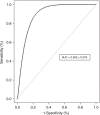Individual and environmental factors associated with the seroprevalence of Borrelia burgdorferi in Belgian farmers and veterinarians
- PMID: 27852421
- PMCID: PMC5112351
- DOI: 10.3402/iee.v6.32793
Individual and environmental factors associated with the seroprevalence of Borrelia burgdorferi in Belgian farmers and veterinarians
Abstract
Background: Lyme disease (LD) is a common tick-borne disease in Europe. Diverse factors at various scales determine the spatial distribution of Borrelia burgdorferi infection risk and a better understanding of those factors in a spatially explicit framework is needed for disease management and prevention. While the ecology of ticks and the landscape favoring their abundance have been extensively studied, the environmental conditions favoring an intense contact with susceptible humans, including groups at risk, are sparse. The aim of this study is to assess which individual and environmental factors can favor B. burgdorferi infection in a Belgian group professionally at risk.
Methods: Serological results of 127 veterinarians and farmers enrolled in this study were analyzed, taking into account their municipality of residence. Using binary logistic regression and considering interaction terms, the joint effects of landscape composition and configuration, and forest and wildlife management were examined.
Results: Seven of the 127 workers were seropositive for LD, leading to a seroprevalence of 5.51%. Seropositivity was higher in older persons. The proportion of forest and semi-natural habitats and wetland had a positive impact on LD seroprevalence while arable land-grassland ecotones had a negative one. Our results confirmed the need to consider complex interactions between landscape variables in order to model risk.
Conclusions: Our data show that LD has to be considered as a risk for farmers and veterinarians. Rather than focusing either on ecological aspects of tick and pathogen distribution or on purely epidemiological aspects such as individual risk factors, our model highlights the role of human-environment interactions in LD risk assessment.
Keywords: B. burgdorferi infection; Belgium; Lyme disease; risk assessment; spatial modeling.
Conflict of interest statement
Conflict of interest and fundingNo competing financial interests exist. This study was kindly supported by Special Research Fund (FSR) grants of the Université catholique de Louvain.
Figures





Similar articles
-
Seroprevalence of Borrelia burgdorferi in Belgian forestry workers and associated risk factors.Parasit Vectors. 2018 May 2;11(1):277. doi: 10.1186/s13071-018-2860-2. Parasit Vectors. 2018. PMID: 29716647 Free PMC article.
-
Prevalence of serological response to Borrelia burgdorferi in farmers from eastern and central Poland.Eur J Clin Microbiol Infect Dis. 2017 Mar;36(3):437-446. doi: 10.1007/s10096-016-2813-7. Epub 2016 Oct 31. Eur J Clin Microbiol Infect Dis. 2017. PMID: 27796648 Free PMC article.
-
Prevalence of Anaplasma phagocytophilum in Ixodes ricinus and Dermacentor reticulatus and Coinfection with Borrelia burgdorferi and Tick-Borne Encephalitis Virus in Western Ukraine.Vector Borne Zoonotic Dis. 2019 Nov;19(11):793-801. doi: 10.1089/vbz.2019.2450. Epub 2019 Jun 18. Vector Borne Zoonotic Dis. 2019. PMID: 31211655 Free PMC article.
-
The role of Ixodes scapularis, Borrelia burgdorferi and wildlife hosts in Lyme disease prevalence: A quantitative review.Ticks Tick Borne Dis. 2018 Jul;9(5):1103-1114. doi: 10.1016/j.ttbdis.2018.04.006. Epub 2018 Apr 16. Ticks Tick Borne Dis. 2018. PMID: 29680260 Review.
-
[Ixodes ricinus, transmitted diseases and reservoirs].Parassitologia. 2004 Jun;46(1-2):119-22. Parassitologia. 2004. PMID: 15305699 Review. Italian.
Cited by
-
Occupational Lyme Disease: A Systematic Review and Meta-Analysis.Diagnostics (Basel). 2022 Jan 25;12(2):296. doi: 10.3390/diagnostics12020296. Diagnostics (Basel). 2022. PMID: 35204387 Free PMC article. Review.
-
Geographical Features and Seroprevalence of Borrelia burgdorferi in Erzincan, Turkey.J Arthropod Borne Dis. 2018 Dec 25;12(4):378-386. eCollection 2018 Dec. J Arthropod Borne Dis. 2018. PMID: 30918907 Free PMC article.
-
First Detection of Seroreactivity to Lyme Borreliosis in Agricultural Workers from a Non-Endemic Region of South Korea.Yonsei Med J. 2025 Jul;66(7):456-458. doi: 10.3349/ymj.2024.0376. Yonsei Med J. 2025. PMID: 40551595 Free PMC article. No abstract available.
-
Using volunteered observations to map human exposure to ticks.Sci Rep. 2018 Oct 18;8(1):15435. doi: 10.1038/s41598-018-33900-2. Sci Rep. 2018. PMID: 30337654 Free PMC article.
-
Systematic Review and Meta-analysis of Lyme Disease Data and Seropositivity for Borrelia burgdorferi, China, 2005‒2020.Emerg Infect Dis. 2022 Dec;28(12):2389-2397. doi: 10.3201/eid2812.212612. Emerg Infect Dis. 2022. PMID: 36417925 Free PMC article.
References
-
- Bigaignon G, Tomasi JP, Goubau P, Martin P, Pierard D, Sindic CJ, et al. A clinical and sero-epidemiological study of 190 Belgian patients suffering from Lyme borreliosis. Acta Clin Belg. 1989;44:174–81. - PubMed
-
- Borchers AT, Keen CL, Huntley AC, Gershwin ME. Lyme disease: a rigorous review of diagnostic criteria and treatment. J Autoimmun. 2015;57:82–115. - PubMed
-
- Lindgren E, Jaenson TGT. Lyme borreliosis in Europe: influences of climate and climate change, epidemiology, ecology and adaptation measures. Copenhagen, Denmark: World Health Organization Regional Office for Europe; 2006. EUR/04/5046250.
-
- De Keukeleire M, Vanwambeke SO, Somassè E, Kabamba B, Luyasu V, Robert A. Scouts, forests, and ticks: impact of landscapes on human-tick contacts. Ticks Tick Borne Dis. 2015;6:636–44. - PubMed
-
- Lakos A, Igari Z, Solymosi N. Recent lesson from a clinical and seroepidemiological survey: low positive predictive value of Borrelia burgdorferi antibody testing in a high risk population. Adv Med Sci. 2012;57:356–63. - PubMed
LinkOut - more resources
Full Text Sources
Other Literature Sources
Research Materials
